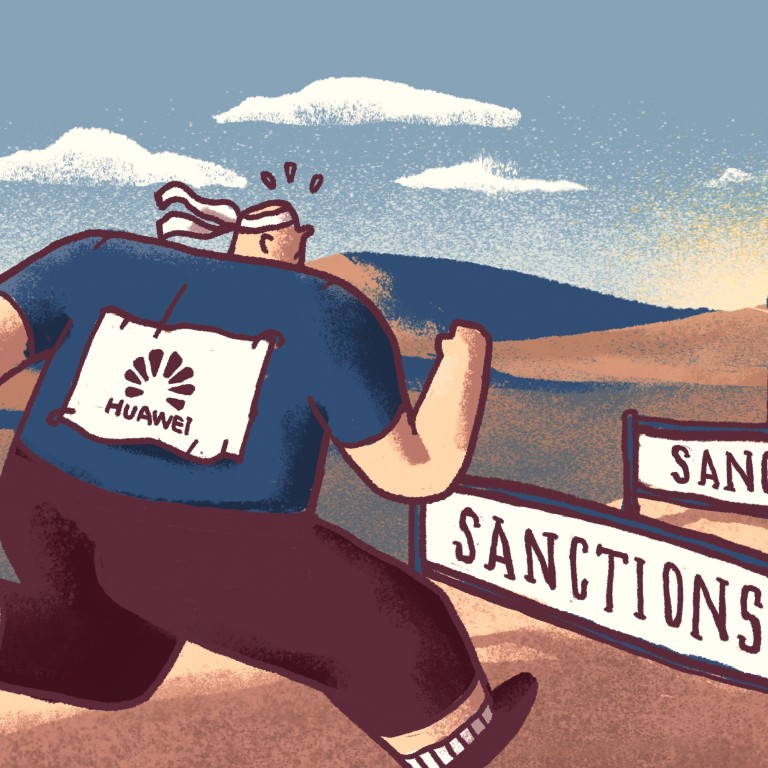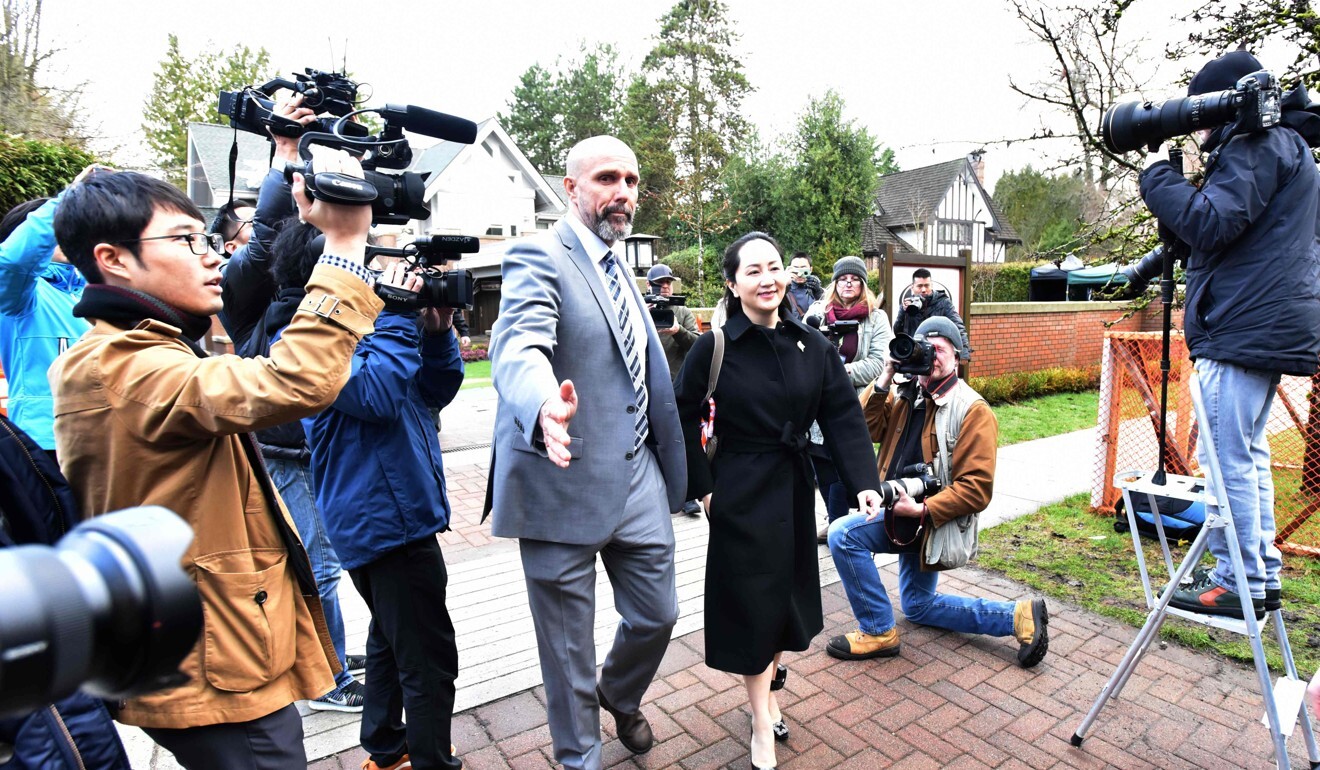
What next for China’s Huawei with Trump upping the ante and the Covid-19 crisis gripping the world?
- In the final instalment of an eight-part series on Huawei, we examine what 2020 may hold for the China telecoms giant as the global health crisis adds to US pressure
- Founder and CEO Ren Zhengfei remains optimistic and says pandemic’s impact is driving new demand for digital services and connectivity
“Despite enormous outside pressure … business remains solid,” said Eric Xu, Huawei’s rotating chairman at the time, in the earnings statement, before adding that the “external environment will only get more complicated going forward”.
Huawei recently said that revenue growth slowed sharply in the first quarter to a slight 1.4 per cent, without breaking out numbers for each of its main business divisions – consumer, carrier and enterprise services. According to research firm IDC, global smartphone shipments are expected to drop 10.6 per cent year on year in the first half of 2020 due to the pandemic.
“If the coronavirus cannot be brought under control in Europe by the first half, Huawei’s carrier business will be hurt due to the delay of local internet construction,” said Jia Mo, an analyst at research firm Canalys. “In terms of smartphones, Huawei’s overseas business will be hurt badly without Google mobile services while the virus limits domestic demand.”
Ren Zhengfei, the founder and CEO of Huawei, is nevertheless optimistic and believes that the impact of the global health crisis has accelerated demand for new digital services.
“The pressure coming from the United States on Huawei's 5G systems has had quite a substantial impact … We have had to spend a lot of our time explaining [the situation] to our customers, partners and also government regulators,” said Xu in March. “Survival will be our first priority.”

When it comes to smartphones and PCs, Huawei has developed its own operating system – Harmony – should US action bar it from using Google’s Android. It has also developed Huawei Mobile Services as an alternative to Google Mobile Services and is investing in the creation of an ecosystem of apps to support the platform.
Huawei led the market for mobile network base stations with a 28 per cent share in 2019, according to New Street Research. The research firm predicts that demand for this equipment will rise this year amid global 5G network buildout, but that the pandemic will delay the timing.
How the US became a no-go zone for Huawei
“China will be Huawei’s key market for 5G in the next two years … and we are bullish about consumer demand for 5G phones in China, but the timing will now likely shift to the second half of 2020 at the earliest,” said Jefferies equity analyst Edison Lee.
But some experts remain sceptical whether Huawei’s efforts will be enough.
“We don't believe that Huawei will be able to successfully replace [in the next 12 months] Google mobile services with a competitive alternative, for handsets destined for overseas markets,” said Jean Baptiste, principal analyst at Atherton Technology Research, a global strategy and intelligence consultancy firm.
“However, over time, Huawei will be able to offer local competitive alternatives to critical Google applications – like TomTom in Europe instead of Google Maps and Brave instead of Chrome or even local payment solutions instead of Google Pay – as well as leveraging tons of open-source software alternatives.”

According to a Reuters news report in February, the US is considering the ‘nuclear option’ of changing US regulations to block TSMC from shipping chips to Huawei.
This would be done by requiring TSMC to apply for a licence to use US chipmaking equipment if it intended to ship the finished devices to Huawei. Wafer foundries like TSMC, as well its smaller rival Semiconductor Manufacturing International Corporation (SMIC) in mainland China, rely on US gear to make their wafers for clients such as Huawei.
“There is nothing Huawei could do if such a move materialises, since only TSMC and Samsung can produce 7nm [wafers] and, starting from 2021, 5nm chipsets,” said Lee from Jefferies. “Samsung doesn’t supply to third parties and thus TSMC is the only choice.”
Xu said in March he hoped the Reuters report was “fake news”, adding that if Washington did do that the Chinese government would have no choice but to do the same to US companies. Earlier this month, a separate Reuters report said that Huawei has begun to gradually shift production of lower end chips designed in-house away from TSMC and towards SMIC in preparation for more potential US restrictions.
Founder says Huawei ‘racing to develop’ new technologies amid pandemic
Jefferies’ Lee thinks the US will avoid ‘mutually assured destruction’ though.
“[A shut-off] would cause potential damage to TSMC's profitability and cash flow, which would impact its overall ability to supply US tech companies … and potentially damage Taiwan’s economy,” said Lee.
Ren underlined that currently Huawei can still buy some US supplies under temporary US waiver schemes.
“US companies can still sell and supply components to us as long as they meet certain standards. We are continuing to buy these components in large quantities,” said Ren in his interview with the Post. “However, if the US government imposes further restrictions … we need to find alternative components … we live in a globalised world, and any missing links will cause problems.”
There are also concerns about Huawei’s partnership with British chip software firm ARM, whose architecture is “the equivalent of Android on the hardware side”. The China operation of ARM said last October that it would continue to supply its Chinese partners, helping to alleviate some of the pressure on Huawei.
“If Huawei is banned from using ARM then it cannot design next-generation chips and there's not really a viable alternative here,” said Atherton’s Baptiste. “Huawei has said it could use open-source chip architecture like RISC-V but that would mean a complete redesign, from the ground up, of all its chips, firmware, drivers … which will most likely be incompatible with the existing Android app ecosystem.”
Aside from organic, in-house development efforts, Huawei has also been on the hunt for partners.
In Russia, the company is talking to local search engine provider Yandex with the aim of adding Yandex’s voice assistant Alisa to its phones, along with other Yandex apps for music, taxis and news, according to a report by Russian local media RIA Novosti in August last year. It is also looking to work with Indian software company OSLabs to build an Android app store that might appeal to India’s hundreds of millions smartphone users, according to a report by ET Telecom last month.
A Huawei spokeswoman declined to comment on these reports.
HiSilicon overtakes Qualcomm as top China smartphone processor supplier
“Huawei is accelerating its efforts to work with publishers, app developers and brands, but it will take time, effort and money to build an effective alternative to Google’s ecosystem,” said Forrester analyst Thomas Husson. “At this stage, I don’t think HMS is an alternative to GMS for overseas markets.”
Continued US pressure and its knock-on effects will remain Huawei’s biggest challenge in 2020.
Angela Merkel, the German chancellor, has backed a strategy paper that opposes any attempt to single out the Chinese telecoms equipment maker, preferring instead to tighten security requirements on all suppliers. A final decision is expected imminently.

However, amid the doom and gloom of the coronavirus, Huawei along with many of China’s tech champions, is eyeing a huge potential growth market in artificial intelligence, with 5G seen as the connective tissue for a host of AI-enabled innovations.
In January, Huawei upgraded its artificial intelligence and cloud unit into a fourth core business group, along with its consumer, carrier and enterprise units.
Launched in 2017, Huawei cloud services has grown quickly with a customer base including the Shenzhen traffic police department, Deppon Express and J&T Express. Last year, the company debuted its AI-backed cloud services in Singapore and Brazil, adding to a global footprint that already includes Hong Kong, Russia, Thailand, Europe and South Africa.
‘I’m just a puppet leader,’ Huawei’s founder Ren Zhengfei says
Still, Alibaba remains the dominant cloud services provider in China, accounting for 46.4 per cent of total spending in the fourth quarter of last year, according to a Canalys report. Tencent and Baidu have market shares of 18 and 8.8 per cent respectively, with Huawei currently below the threshold of disclosure.
There is also some optimism that the health crisis will accelerate the buildout of 5G networks, which can support increased demand for services such as online education, health and work-from-home services.
“I think the pandemic will help Huawei push through the US campaign to prevent other developed countries from adopting Huawei 5G technology,” said Mike Feibus, a research analyst at Feibustech. “As the world economy works to recover in the wake of coronavirus damage … 5G roll-out will be critical. So I expect the resistance against the US will become more forceful in coming quarters.”
Ren agrees with this analysis.
“New technologies such as tele-health, online learning and remote working have showed to the world their usefulness in preventing disease from spreading, as well as the importance of network connections,” Ren told the Post. “Even when the West is feeling the mounting impact of the coronavirus, most of our projects can actually enhance their capabilities. There is a demand we need to meet.”
Other parts of this series have examined how the US became a no-go zone for Huawei, what it’s it like working for them, founder Ren Zhengfei’s view of himself as a leader, the firm’s role in China’s belt and road plan, the spotlight on cybersecurity, the US-China tech war and the company’s ‘wolf culture’.










